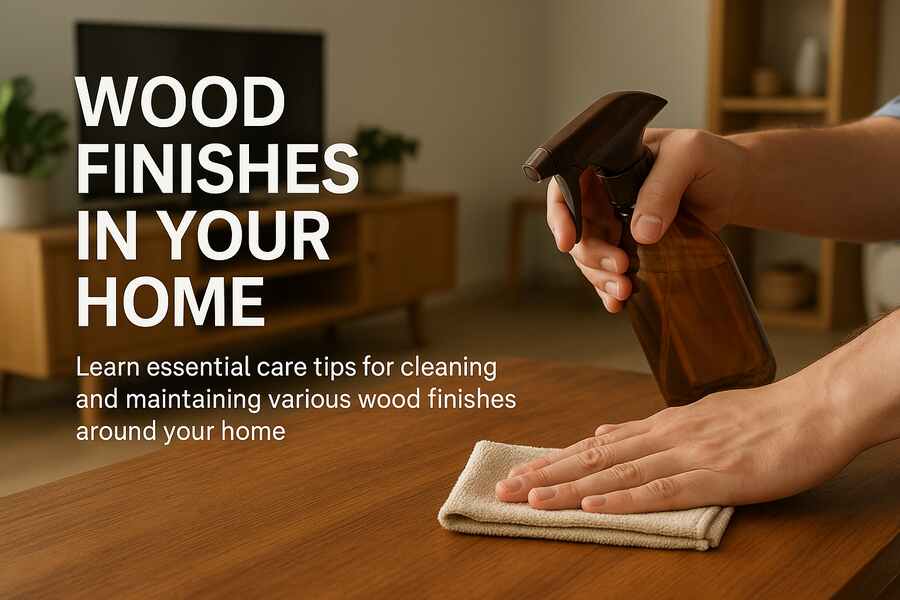Wood Finishes in Your Home: Cleaning & Care Tips
Are your wooden surfaces looking dull no matter how much you clean them? One can easily assume that a quick dusting and polishing would suffice for the work. Non-standardized finishes require different treatment. A cleaning method detrimental to one finish might prove advantageous for another. Whether lacquered and mirror-like, warmly oil-finished and smooth, or painted and subdued, each wood finish needs really careful cleaning. Have you ever wondered how to care for your wood surfaces so that you may keep them spotless? Well, you are not alone! This blog guides you through ways to clean and maintain different wood finishes around your home so you can protect their beauty and enjoy their charm for years.
1. Multipurpose and Different Types of Wood Finishes
It is also essential to understand the kind of home wood finishes before going into techniques, suggested by Bond Cleaning Perth. Made with Lacquer to look sleek and glossy, most modern furniture uses Lacquer. Floors are hard-wearing and painted with varnish. Oil finishes are natural and have a matty finish. Polyurethane is so strong and waterproof and can be found in kitchens and bathrooms. Wax finishing works as a soft sheen, which can be applied to an antique. Furniture and trim get personality and colour painted on wood. They respond in different ways to moisture, heat and cleaners and therefore require customised care.
2. Cleaning Lacquered Wood: The Alive Shine
Lacquered wood is elegant yet it is sensitive to harsh chemicals. Clean the dust frequently with a lint-free and soft cloth. In the case of more thorough cleaning, spray a cloth that has been lightly wet with warm water and mild dish soap. Out of care, wipe the surface followed by drying it using a microfiber cloth. Do not use alcohol or ammonia-based products since they work against the shine. Gentle furniture polish once a month is necessary to keep gloss.
3. Care of Varnished Wood: Long Life Woodwork
Varnished wood is strong, and it can be used in busy sections. Once a week, dust and sometimes clean with a slightly damp cloth and a mild soap. Instantly wipe the surface to avoid the kind of stains that water leaves. Avoid any scouring pads or rough powders, as recommended in the Safe Work Australia cleaning guidelines.. Apply paste wax to frequently-used sections every two months or so, and revarnish worn spots.
4. Oil Finished Wood Care: Deep Food
Natural wood texture is promoted using oil finishes. Begin by dusting with a dry or slightly wet cloth. Apply oil-based soaps such as Murphy Oil Soap to clean up your lamp occasionally in a deep clean. There should never be water left lying around on the surface of the water, as it may leave stains. These types of oils, such as Danish or linseed, should be applied again after every few months to rejuvenate the wood. Never use vinegar or anything with a chemical cleaner, which takes the finish off.
5. Polyurethane Coated Surfaces: Tricky yet Tough to Clean
Polyurethane finishes are tough and may fog when misused. Clean in case of spillage as soon as it happens. Wipe off using a soft cloth and some mild soap solution. Steam mops or wetting the cloths should not be used; excess moisture tends to break the finish. Polish now and again with chemicals free of polyurethane, and never spray oily chemicals, which can cause a residue.
6. Care of Wax-Finished Wood: Soft Hands Needed
Decorative works are made of wax-finished wood, which is fragile. Wipe off the dust using a cotton cloth. And, in case of necessity, wipe with a damp piece of cloth and light soap and never soak the surface. Rub on fresh paste wax every few months in circular movements and then buff to a soft sheen. It should be kept out of the direct sun and heat that may cause the wax to melt or crack.
7. Looking after Wood that is Painted: Handle Colour with Care
Stained wood is lovely yet can easily be chipped should one handle it in a manner that is not good. Dust frequently, but something with a wet rail and mild soap. Do not scrub or use abrasive cleaners. In the case of the scuff marks, a soft paste of baking soda should be used. Avoid bleach, acetone and strong chemicals. Mend chipped exteriors with touch-up.
8. Habits of General Wood Care to be Followed
No matter which one is the finish, the following universal advice extends the lifespan of wood. Furniture should avoid the impact of direct sunlight so as to avoid fading or cracking. Avoid heat and moisture rings by the use of coasters, mats or trivets. In order to keep the humidity levels within the house constant because wood will swell and shrink when wet. Lifting furniture instead of dragging it on the floor or surfaces should be the first step in the removal of furniture.
Conclusion
Wood finish is characterful, warm, and elegant in a home, provided it is in tip-top shape. Some little is a lot. Be aware of the particular requirements of these wood finishes, and you can clean freely and maintain the appearance and life of your furniture, floors and decorative items. Next time, when you get ready to grab a cleaning cloth, pause a moment to think of the finishing, select the appropriate technique and treat wooden surfaces in the way they should be treated. Timeless beauty which lasts will be your gift to your home.


